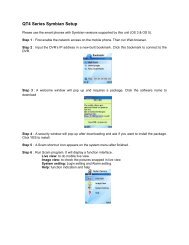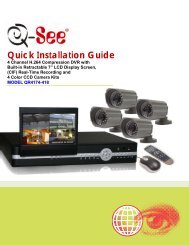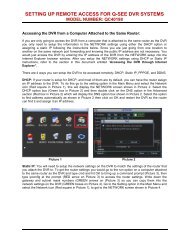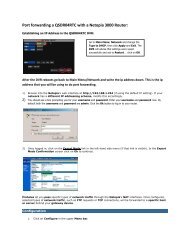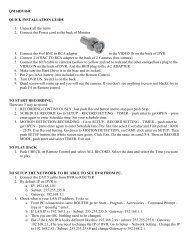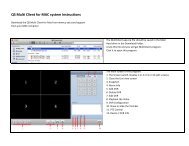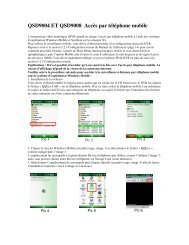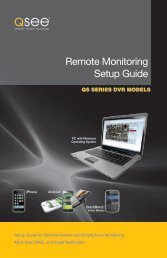Mobile Remote Monitoring Using QS View for iOS and ... - Q-See
Mobile Remote Monitoring Using QS View for iOS and ... - Q-See
Mobile Remote Monitoring Using QS View for iOS and ... - Q-See
Create successful ePaper yourself
Turn your PDF publications into a flip-book with our unique Google optimized e-Paper software.
You will need to add your DVR to the Device<br />
List in order to connect.<br />
Once you’ve added your DVR to the list, you<br />
can tap on it to connect to it.<br />
Tap on the Device icon to open the Device<br />
List. PICTURE 3<br />
To add a DVR to your list, tap the + (<strong>iOS</strong>)<br />
or Add (Android) button in the upper right<br />
corner.<br />
While in Live <strong>View</strong>, you may switch between<br />
Devices by tapping the Select button in the<br />
upper right corner. This will cause a list of<br />
your available DVRs to pop up allowing you<br />
to choose which system to access.<br />
Later, you can use this window to edit or<br />
delete DVRs in your list by using the Edit<br />
button on the upper left.<br />
PICTURE 6<br />
PICTURE 4<br />
Clicking on the + or Add button opens<br />
another window allowing you to enter<br />
the DVRs IP address <strong>and</strong> other essential<br />
in<strong>for</strong>mation, such as the user name <strong>and</strong><br />
password. These are the same as you use to<br />
log into the DVR.<br />
It is recommended that you create two<br />
“Devices” <strong>for</strong> each DVR. One should use the<br />
local IP address <strong>for</strong> when you are accessing<br />
the same network that the DVR is connected<br />
to, while the other will use the WAN IP <strong>for</strong><br />
when you are connecting over the Internet.<br />
PICTURE 5




